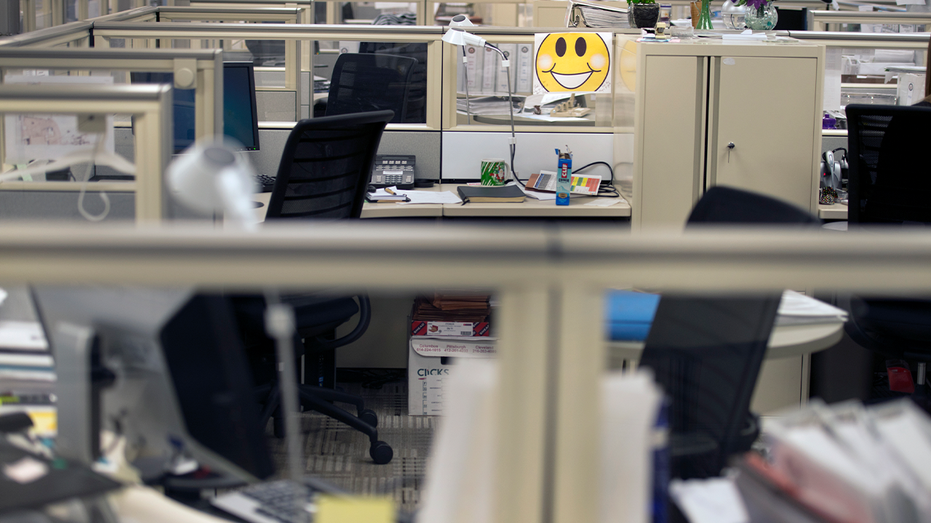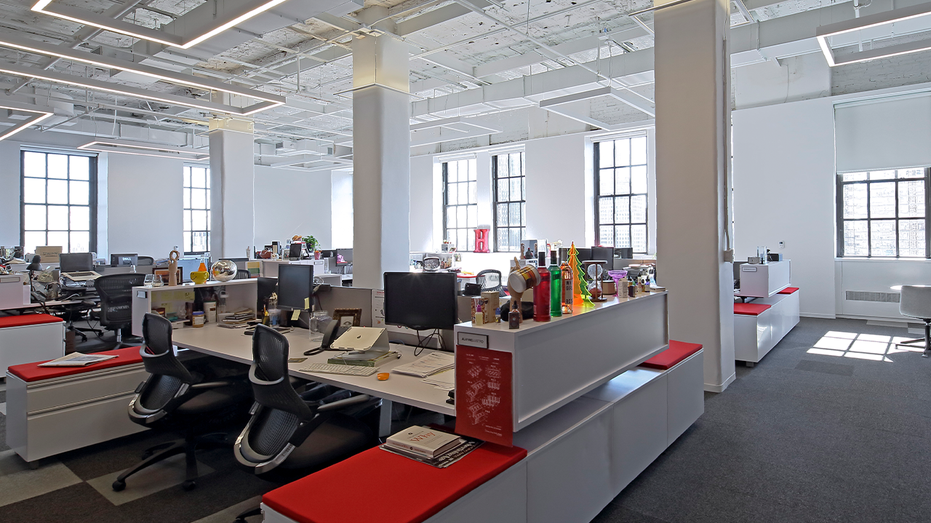America’s offices are the emptiest they've been in at least four decades, according to report
Nearly 20% of offices are sitting empty, which is the highest number on record, according to report
Employers are seeing a need for ‘different’ office space: Bruce Mosler
Bruce Mosler, global brokerage chairman at Cushman and Wakefield, joined 'Varney & Co.’ to discuss the impact remote work has had on New York City office space.
America’s offices are the emptiest they've been in at least four decades as a result of the pandemic and the rise in remote work. Nearly 20% of offices are sitting empty, according to a recent report released by Moody Analytics.
The national office vacancy rate rose to 19.6% in the fourth quarter of 2023, setting the highest record since at least 1979 when Moody first started tracking office vacancies, according to the report. In 1986 and 1991, that number was around 19.3%, while the average pre-pandemic office vacancy rate sat at around 16.8%.
The Wall Street Journal reported that the high percentage of empty office space can also be attributed to the office-market downturn of the ’80s and ’90s, which resulted from overbuilding accelerated by easy lending, which prompted a construction boom, particularly in the South. In addition, when the 19.3% number was seen in 1986, it was driven by a 5-year period of significant inventory expansion, while the uptick in 1991 was attributable to the Savings and Loans Crisis, the report found.

Dozens of empty cubicles occupy space where naval civilians that are federal government employees temporarily left behind, due to the government shutdown at the Office of the Chief of Naval Personnel in Arlington, Virginia, on October 01, 2013. (Photo by Marvin Joseph/The Washington Post via Getty Images / Getty Images)
The three major U.S. cities with the country’s highest office-vacancy rates are all in Texas – Houston, Dallas and Austin – and new construction is at the lowest levels seen since 2012, according to the report and Moody’s data shared with Fox News Digital. The trends are in line with the 20th century building boom in the South that was fueled by cheap land and fewer regulations, as reported by the Wall Street Journal.
Because banks often financed office projects that didn’t have any tenants signed up, there were more office buildings than tenants when the 1990 recession hit, the Wall Street Journal reported. Offices built in the '80s still struggle to find tenants and the impact on today's market partially accounts for the U.S.'s higher number of vacancies when compared to Europe or Asia.
Thomas P. LaSalvia, the head of commercial real estate economics at Moody’s CRE, told Fox News Digital that the current office scenario is more similar to the ‘80s and ’90s than people think.
SAN FRANCISCO STRUGGLING TO FILL EMPTY DOWNTOWN STOREFRONTS: ‘VACANCIES OPERATE LIKE A VIRUS’
"Communications technology had advanced to the point of making offices and cities obsolete," he said. "Square footage per employee dropped considerably, but yet instead of obsolescence, we saw a renaissance of both. In-person communication became even more valuable as the US economy grew due to being a leader in the knowledge-based economy."

Tribeca Office, New York City, United States. Architect: HOK International Ltd, 2015. (Photo by: Susan Fisher Plotner/View Pictures/Universal Images Group via Getty Images / Getty Images)
"The pandemic has undoubtedly put all of this into question again," he added. "One big change is that there is now a realization that people actually like cities for things other than work, and studies will show that central meeting places (offices) are still valuable, especially for important client meetings as well as gaining deeper relationships with colleagues/co-authors that the virtual world still can’t quite replicate."
DEAL FOR OFFICE SPACE NEAR BIG CITIES BETS ON SUBURBAN LIFESTYLE, REMOTE WORK
However, there are recognizable differences between the downturn in the early 1990s that ended once the economy started booming again and the current downturn, which analysts expect to be longer lasting as more employees opt for remote or hybrid work. In addition, many companies have opted for cubicles and open floor concepts instead of private offices to cut back on costs, which has prompted more vacancies that were only accelerated by the COVID-19 pandemic.
NYC COMMERCIAL REAL ESTATE FACING RECORD VACANCIES, LOW OCCUPANCY: ‘PEOPLE ARE NOT COMING BACK’
Tenants are attracted to Class A properties which "offer flexible or smaller configurations" and are "particularly attractive to tenants who decide to keep the physical office footprint for branding, purposeful gathering, training, and collaboration purposes," the report found. In addition, suburban offices saw fewer vacancies, which Moody attributed to their closer proximity to local communities, as well as shorter commute times.

YOOX Net-A-Porter Offices, London, United Kingdom. Architect: Grimshaw, 2017. (Photo by: Anthony Weller/View Pictures/Universal Images Group via Getty Images / Getty Images)
That said, LaSalvia said this doesn't mean there isn't obsolescence and trouble for certain assets and neighborhoods, adding that it wouldn't surprise him if the vacancy rate continues to hover around 20%.
"Change is upon us, and often time change is messy," he said. "There will be ghost office buildings (like malls of the past two decades)."
CLICK HERE TO GET THE FOX NEWS APP
"This is a time where investors and lenders have to be incredibly vigilant and detail oriented, but that will expose some very good opportunities," he added.




















